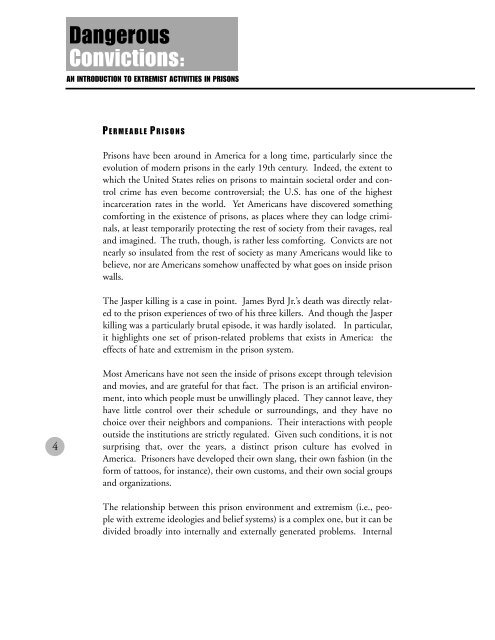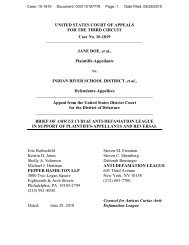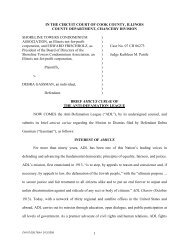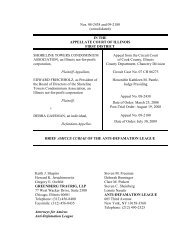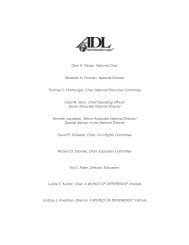Dangerous Convictions for PDF - ADL
Dangerous Convictions for PDF - ADL
Dangerous Convictions for PDF - ADL
Create successful ePaper yourself
Turn your PDF publications into a flip-book with our unique Google optimized e-Paper software.
4<br />
<strong>Dangerous</strong><br />
<strong>Convictions</strong>:<br />
AN INTRODUCTION TO EXTREMIST ACTIVITIES IN PRISONS<br />
P ERMEABLE P RISONS<br />
Prisons have been around in America <strong>for</strong> a long time, particularly since the<br />
evolution of modern prisons in the early 19th century. Indeed, the extent to<br />
which the United States relies on prisons to maintain societal order and control<br />
crime has even become controversial; the U.S. has one of the highest<br />
incarceration rates in the world. Yet Americans have discovered something<br />
com<strong>for</strong>ting in the existence of prisons, as places where they can lodge criminals,<br />
at least temporarily protecting the rest of society from their ravages, real<br />
and imagined. The truth, though, is rather less com<strong>for</strong>ting. Convicts are not<br />
nearly so insulated from the rest of society as many Americans would like to<br />
believe, nor are Americans somehow unaffected by what goes on inside prison<br />
walls.<br />
The Jasper killing is a case in point. James Byrd Jr.’s death was directly related<br />
to the prison experiences of two of his three killers. And though the Jasper<br />
killing was a particularly brutal episode, it was hardly isolated. In particular,<br />
it highlights one set of prison-related problems that exists in America: the<br />
effects of hate and extremism in the prison system.<br />
Most Americans have not seen the inside of prisons except through television<br />
and movies, and are grateful <strong>for</strong> that fact. The prison is an artificial environment,<br />
into which people must be unwillingly placed. They cannot leave, they<br />
have little control over their schedule or surroundings, and they have no<br />
choice over their neighbors and companions. Their interactions with people<br />
outside the institutions are strictly regulated. Given such conditions, it is not<br />
surprising that, over the years, a distinct prison culture has evolved in<br />
America. Prisoners have developed their own slang, their own fashion (in the<br />
<strong>for</strong>m of tattoos, <strong>for</strong> instance), their own customs, and their own social groups<br />
and organizations.<br />
The relationship between this prison environment and extremism (i.e., people<br />
with extreme ideologies and belief systems) is a complex one, but it can be<br />
divided broadly into internally and externally generated problems. Internal


